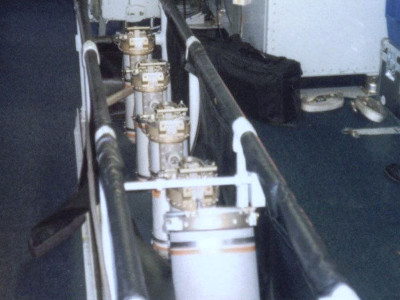
SMILE / OPTICS
Sonobouy Missile Impacting Locating System
The Sonobuoy Missile Impact Location System (SMILS) combines airborne equipment with prepositioned Deep Ocean Transponder (DOT) arrays located on the ocean floor in various parts of the world to enable accuracy scoring of ballistic missile impacts during test firings. It uses a variety of sonobuoys launched from the support aircraft to gather background acoustic information from the ocean environment and navigation information from the DOTs, and transmit this information as audio via RF links to the plane where recording takes place with a database created. When the ballistic missile reentry vehicles (RVs) impact in or around the sonobuoy array, the buoys transmit the impact audio to the aircraft where combined, with timing and the previously gathered buoy navigation data, and recorded to compute an impact location and time for each RV. The ARIA optics system is a set of fixed staring cameras aimed out on the left side of the aircraft designed for photo documentation of ballistic missile reentries and impacts. It provides visual verification of RV cloud penetration, the total number of RVs surviving to impact, and time correlation of these events, and any visual snomalies. During the missile reentry phase of flight, the ARIA flies a flight path that is skew to the flight path of the RVs and approximately 15 or more miles away to avoid any chance of collision. During this period, the ARIA flies straight and level. The cameras turned on with the data recorded on film and videotape. The heading and timing of this flight path are critical and carefully planned, ensuring that all RVs remain within the field of view of both the cameras and the telemetry antenna.
After mission completion, the raw film typically is turned over to the using agency for processing. Each camera looks through its optical quality window, kept free of fog by forced, heated air, over a field of regard of approximately 40 to 130 degrees off aircraft heading (horizontal) and 45 above to 25 degrees below the horizon (vertical). Perkin Elmer manufactures the optical windows which each camera looks through from Schott BK- 7 type glass. These windows have been enlarged for the streak and framing cameras to expand their field of view; the windows are approximately 18 x 13 inches and 13 x 13 inches, respectively. The total field-of-view depends upon the camera and lens selected. Each of the cameras can be operated at the rack or at a remote operator station, where the operator can observe visual events in real-time on a video monitor and flag events of interest on an audio track of the videotape. The system consists of four cameras, timing, and control equipment, a video recorder, and a vacuum pump — the ballistic streak camera is used for time exposures during twilight or nighttime conditions. As the RVs pass into the atmosphere upon reentry, they heat up and glow, and recorded on film as streaks of light, separated horizontally due to forward aircraft motion. While the camera shutter is open, the aperture can be modulated downward at a known rate, thus providing a relative time correlation. Electrical pulses corresponding to the aperture modulation and shutter opening/closing are recorded on the telemetry tape along with IRIG timing. Filters and spectral gratings are available for use with this camera. With the single available lens, it provides a field of view (az x el) of approximately 53 x 74 degrees at its optimum positioning. Framing camera use is for high quality still frame pictures at 1, 2, or 4 frames per second and can also supplement as a second "streak" camera. It places a decimal time annotation based on IRIG-B timing in the corner of each film frame with a resolution of 1 second. It also outputs electrical pulses corresponding to shutter opening/closing for recording on the telemetry tape. Filters and spectral gratings are available for use with this camera. With its single available lens, it provides a field of view (az x el) of approximately 53 x 74 degrees. The cine-camera is a medium-speed motion picture camera designed to operate in a range of 10 to 200 frames per second. IRIG-B timing is placed directly onto the film edge for event correlation, and an electrical pulse corresponding to shutter opening is output for recording on the telemetry tape. Filters and spectral gratings are available for use with this camera. With available lenses, it provides a field of view (az x el) of from 7 x 5 degrees to 68 x 57 degrees.
Credit: United States Air Force
Editor: Randy L. Losey